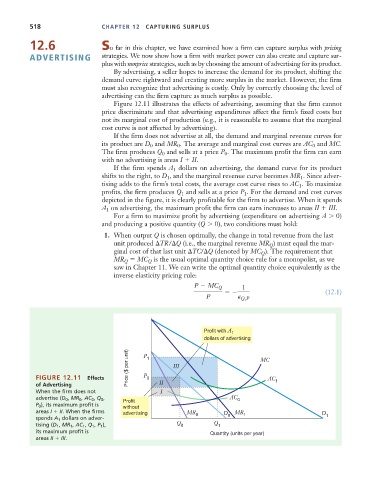Page 544 - Microeconomics, Fourth Edition
P. 544
c12capturingsurplus.qxd 7/22/10 10:41 AM Page 518
518 CHAPTER 12 CAPTURING SURPLUS
12.6 So far in this chapter, we have examined how a firm can capture surplus with pricing
ADVERTISING strategies. We now show how a firm with market power can also create and capture sur-
plus with nonprice strategies, such as by choosing the amount of advertising for its product.
By advertising, a seller hopes to increase the demand for its product, shifting the
demand curve rightward and creating more surplus in the market. However, the firm
must also recognize that advertising is costly. Only by correctly choosing the level of
advertising can the firm capture as much surplus as possible.
Figure 12.11 illustrates the effects of advertising, assuming that the firm cannot
price discriminate and that advertising expenditures affect the firm’s fixed costs but
not its marginal cost of production (e.g., it is reasonable to assume that the marginal
cost curve is not affected by advertising).
If the firm does not advertise at all, the demand and marginal revenue curves for
its product are D and MR . The average and marginal cost curves are AC and MC.
0
0
0
The firm produces Q and sells at a price P . The maximum profit the firm can earn
0
0
with no advertising is areas I II.
If the firm spends A dollars on advertising, the demand curve for its product
1
shifts to the right, to D , and the marginal revenue curve becomes MR . Since adver-
1
1
tising adds to the firm’s total costs, the average cost curve rises to AC . To maximize
1
profits, the firm produces Q and sells at a price P . For the demand and cost curves
1
1
depicted in the figure, it is clearly profitable for the firm to advertise. When it spends
A on advertising, the maximum profit the firm can earn increases to areas II III.
1
For a firm to maximize profit by advertising (expenditure on advertising A 0)
and producing a positive quantity (Q 0), two conditions must hold:
1. When output Q is chosen optimally, the change in total revenue from the last
unit produced TR/ Q (i.e., the marginal revenue MR ) must equal the mar-
Q
ginal cost of that last unit TC/ Q (denoted by MC ). The requirement that
Q
MR MC is the usual optimal quantity choice rule for a monopolist, as we
Q
Q
saw in Chapter 11. We can write the optimal quantity choice equivalently as the
inverse elasticity pricing rule:
P MC Q 1
(12.1)
P Q,P
Profit with A 1
dollars of advertising
Price ($ per unit) P 1 III MC
FIGURE 12.11 Effects P 0 AC 1
of Advertising II
When the firm does not
I
advertise (D 0 , MR 0 , AC 0 , Q 0 , Profit AC 0
P 0 ), its maximum profit is
without
areas I II. When the firms advertising MR 0 MR 1
spends A 1 dollars on adver- D 0 D 1
tising (D 1 , MR 1 , AC 1 , Q 1 , P 1 ), Q 0 Q 1
its maximum profit is Quantity (units per year)
areas II III.

